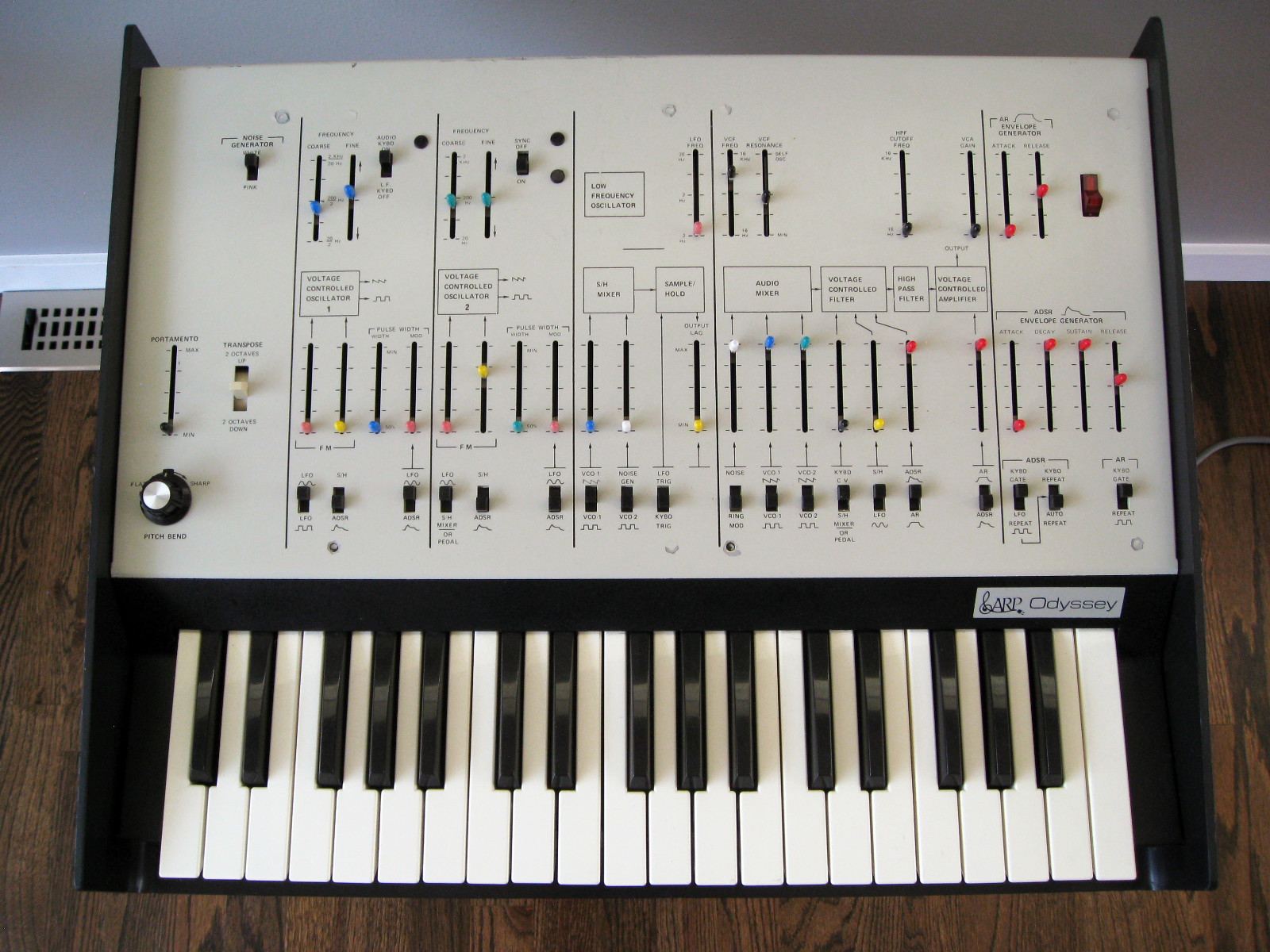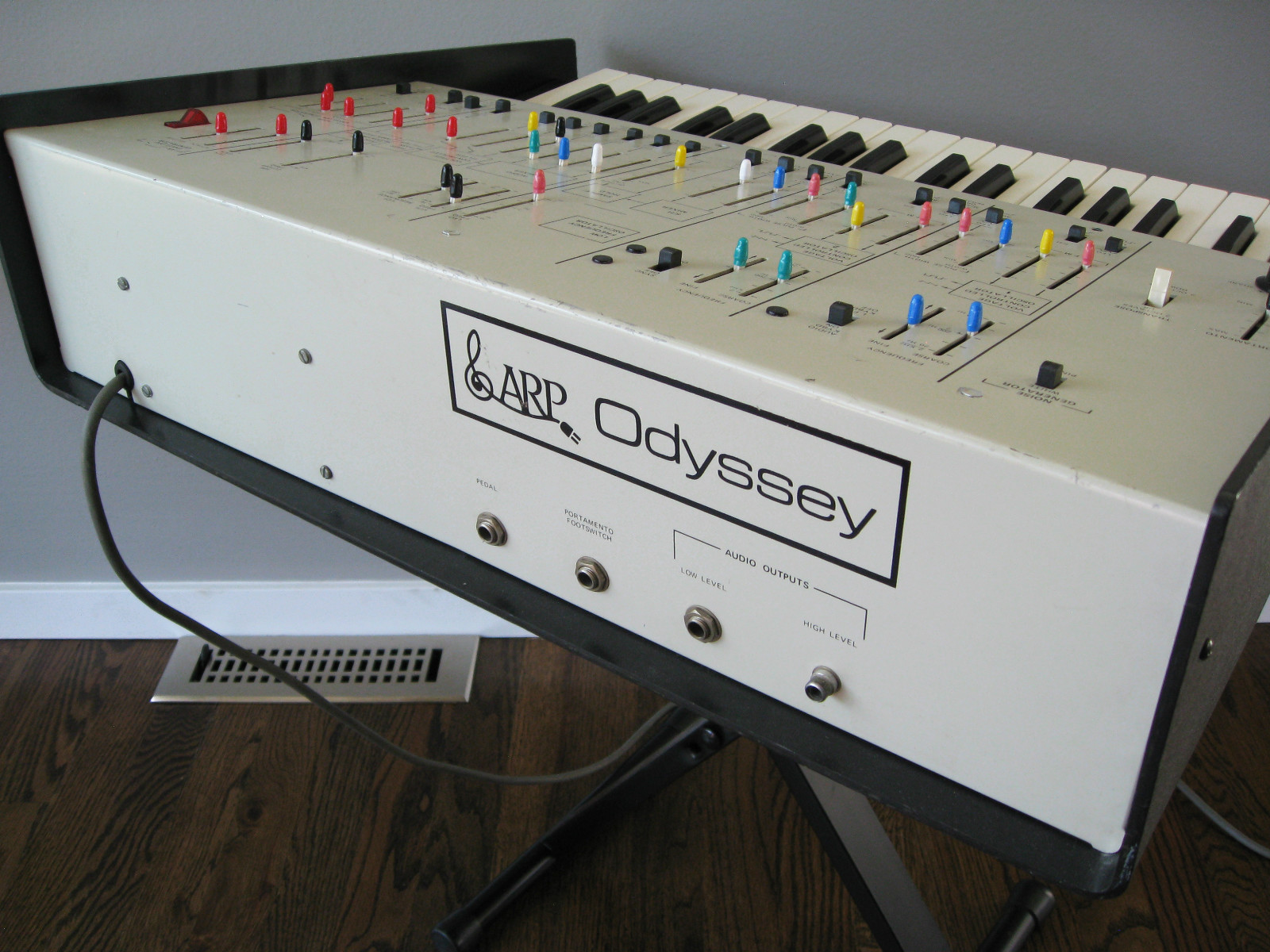Filter on ALL, SYNTH, DRUM, SAMPLER or MISC |
Total list currently 2405 items in 330 Brands |
ARP | Odyssey rev1 |
Description | While the Minimoog proved to be a runaway success as the first compact studio synthesizer, ARP responded with a compact and user-friendly studio synthesizer of their own with the Odyssey in 1972. An almost equally legendary machine itself, the Odyssey was ARP's highest selling synth back then, and still is to this day in the second-hand market. The Odyssey essentially gives you a simplified hard-wired ARP 2600 in a much smaller and affordable package. The Odyssey is a 2-oscillator analog synth (with duo-phonic capability) and it sounds really nice; the Minimoog has three oscillators and is capable of thicker sounds. The Odyssey comes well equipped with all the tweakable features and analog goodness you'd expect: a resonant low pass filter, ADSR envelopes, sine or square wave LFO, and a sample-and-hold function. The Odyssey also added a few new features such as a high pass filter that could be used in series with the low pass, oscillator-sync capability, and pulse-width modulation. It is a very professional and expressive machine that can create nice analog basses, interesting leads, great effects and sweeping sounds straight out of a Tangerine Dream album! There were many versions of the Odyssey over the years, each a little different. They can be broken down into 8 models spanning 3 Mark "Mk" versions. Odyssey Mk I (Model 2800) First came the Odyssey Mk I (Model 2800) produced between 1972-75. These used a smooth but tinny sounding 2-pole voltage-controlled filter design (model 4023) similar to those used in the Oberheim SEM modules. From 1972 to 74 the Odyssey was produced with a white-faced front panel with black lettering. During 1974 to 75 they switched to a redesigned black front panel with gold lettering. However, all Mk I's can be identified by the rotary knob they use for pitch bending. None had any interface jacks, but a factory modification was available to add interface jacks as well as a PPC pitch bender in place of the rotary knob. Mk I Models
|
||||||||||||||||||||||||||||||||||||
| Brand | ARP | ||||||||||||||||||||||||||||||||||||
| Model | Odyssey rev1 | ||||||||||||||||||||||||||||||||||||
| Device | Synth | ||||||||||||||||||||||||||||||||||||
| Type | Keys | ||||||||||||||||||||||||||||||||||||
| Engine Type | Analog | ||||||||||||||||||||||||||||||||||||
| Engine | VCO | ||||||||||||||||||||||||||||||||||||
| Voices (max) | 1/2 | ||||||||||||||||||||||||||||||||||||
| Oscillators | 2 | ||||||||||||||||||||||||||||||||||||
| LFO | Sine / Square; sample-and-hold | ||||||||||||||||||||||||||||||||||||
| Noise | Y | ||||||||||||||||||||||||||||||||||||
| Engine Detailed | 2 VCO's: saw, square, pulse, pwm (can be modulated by: sine LFO or ADSR envelope), white/pink noise; oscillator-sync modulated by: ADSR, square/saw LFO, sample-and-hold | ||||||||||||||||||||||||||||||||||||
| Filter (VCF) | Model 4023 (Early models): 2-pole bi-quad design with low pass output. Model 4035 & 4075 (later models): Four-pole resonant 24dB lowpass filter, high pass filter (static); can be modulated by: keybd track, sample-and-hold, sine LFO, ADSR, AR; ring modulator | ||||||||||||||||||||||||||||||||||||
| Envelope (VCA) | EG 1: AR; EG 2: ADSR | ||||||||||||||||||||||||||||||||||||
| Keys | 37 | ||||||||||||||||||||||||||||||||||||
| Key type | Keys | ||||||||||||||||||||||||||||||||||||
| Velocity | No | ||||||||||||||||||||||||||||||||||||
| Aftertouch | No | ||||||||||||||||||||||||||||||||||||
| CV-gate | CV/GATE (models 2810 - 2823) | ||||||||||||||||||||||||||||||||||||
| Extra info | 3 versions with various models | ||||||||||||||||||||||||||||||||||||
| Produced: | 1972 - 1981 | ||||||||||||||||||||||||||||||||||||
| Legend: | Obvious | Y: Yes, N: No, N/A: Not Applicable | |
| VCO | Voltage Controlled Oscillator | DCO | Digital Controlled Oscillator |
| LFO | Low Frequency Oscillator | Sub | Sub Oscillator |
| VCF | Voltage Controlled Filter | VCA | Voltage Controlled Amplifier |
| Velocity | As with a piano, the harder you hit a key, the louder the sound, unlike most organs which always produce the same loudness no matter how hard you hit a key. | Aftertouch | Pressing a key after you activated it. Channel Aftertouch, no matter which key, it will send a Channel message. Poly Aftertouch, sends the pressure per key instead of the whole channel. |
| Values for OSC, LFO, Filter, Envelope are per voice unless stated otherwise. | |||




